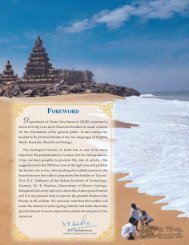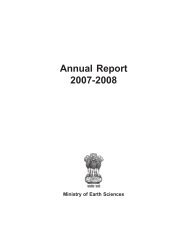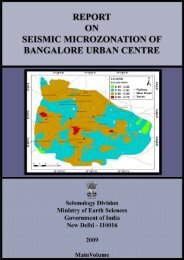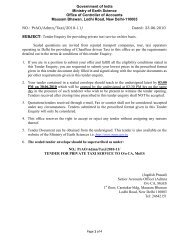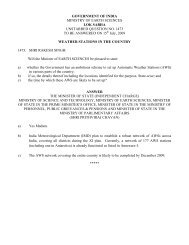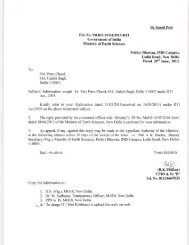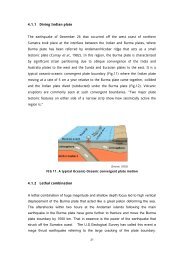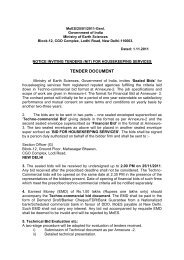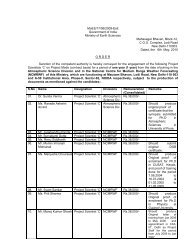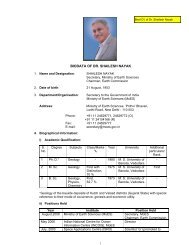Annual Report 2009-2010 - Ministry Of Earth Sciences
Annual Report 2009-2010 - Ministry Of Earth Sciences
Annual Report 2009-2010 - Ministry Of Earth Sciences
You also want an ePaper? Increase the reach of your titles
YUMPU automatically turns print PDFs into web optimized ePapers that Google loves.
4 th Southern Ocean Expedition<br />
The 4 th Southern Ocean Expedition consisting<br />
of 19 scientific and 1 technical personnel from<br />
different national institutions was launched from<br />
Goa on the 12 th January, <strong>2010</strong> on board TDV Sagar<br />
Nidhi for continuing the time series and other<br />
scientific investigations in the southern ocean<br />
region. Dr. Anil Kumar, Scientist-D, NCAOR is the<br />
Chief Scientist of the expedition. The expedition<br />
is on its voyage back. The following scientific<br />
investigations are being undertaken during the<br />
current expedition include biogeochemistry,<br />
hydrodynamics, palaeoceanography oceanatmosphere<br />
interaction, carbon dynamics, etc.<br />
4.5 In-House Research and Development<br />
4.5.1 Antarctic Ice Core Research<br />
Field studies to collect Ground Penetrating Radar<br />
(GPR) data to study the glaciological features<br />
and to decide the ice core drilling locations are<br />
underway in the central Dronning Maud Land<br />
during the current Indian Antarctic Expedition.<br />
An integrated study using instrumental data from<br />
the Halley station and an ice core from the Central<br />
Dronning Maud Land in East Antarctica revealed<br />
that switches in the Southern Annular Mode<br />
(SAM)-temperature relationship are more likely to<br />
reflect natural variability in the long wave patterns<br />
over the Southern Ocean rather than the influence<br />
of an anthropogenic forcing.<br />
The high resolution isotopic and accumulation<br />
studies covering a period of past two decades using<br />
a shallow firn core were undertaken in combination<br />
with the instrumental data of Novlazarevskaya<br />
station in the Central Dronning Maud Land region.<br />
Microbiological studies in fresh snow deposits in<br />
the coastal Antarctica revealed the crucial role of<br />
bacteria in the air-snow biogeochemical cycling in<br />
this region.<br />
Glaciochemical and microbiological study of snow<br />
from coastal Larsemann Hills, East Antarctica<br />
revealed that elevated nutrient concentrations<br />
in ice cap snow are responsible for the observed<br />
high bromide concentration in snow related to<br />
the enhanced growth of microalgae in snow and<br />
subsequent production of bromo-carbons.<br />
4.5.2 Linkages of Indian Monsoon with Southern<br />
Indian Ocean and Southern Ocean<br />
Several palaeoclimatic studies have suggested<br />
strong correlation between the Indian summer<br />
monsoon and northern hemisphere high latitude<br />
climate for the past several thousand years. But<br />
the linkages of Indian monsoon with the southern<br />
hemisphere have received little attention in spite<br />
of the fact that the SST and the upper ocean<br />
heat content of the southern Indian Ocean is the<br />
key factor for the evolution of boreal monsoon<br />
and plays a major role in moisture convergence<br />
and its supply to the Asian summer monsoon.<br />
The Southern Ocean plays an important role in<br />
governing earth’s climate through formation<br />
of major deep and intermediate water masses<br />
(e.g., Antarctic Bottom Water, Circumpolar<br />
Deep Water, Antarctic Intermediate Water etc.)<br />
and through air-sea interactions (such as airsea<br />
fluxes of heat, momentum, freshwater etc.)<br />
processes. Present day climatological studies have<br />
shown that the Southern Ocean exerts control<br />
over Indian monsoon via coupled atmosphericoceanic<br />
pathways. It has been observed that<br />
Southern Annular Mode (SAM) in its strong<br />
positive phase causes increased SST over the<br />
subtropics (~20-35°S) and middle latitudes (~50-<br />
60°S), which in turn is followed by enhanced SST<br />
in the equatorial Indian Ocean, which weakens<br />
the Indian monsoon. But the question remains<br />
whether this relationship is persistent and what<br />
was its response to past periods of climatic<br />
changes. During the ongoing expedition to the<br />
Southern Ocean, cores are being collected from<br />
the strategic locations on which high resolution<br />
isotopic and chemical studies will be carried out<br />
that would aid in exploring this correlation. For<br />
carrying out isotopic analysis of seawater samples,<br />
a new Marine Stable Isotope lab is coming up<br />
at NCAOR.<br />
24 <strong>Ministry</strong> of <strong>Earth</strong> <strong>Sciences</strong> : <strong>Annual</strong> <strong>Report</strong> <strong>2009</strong>-10




